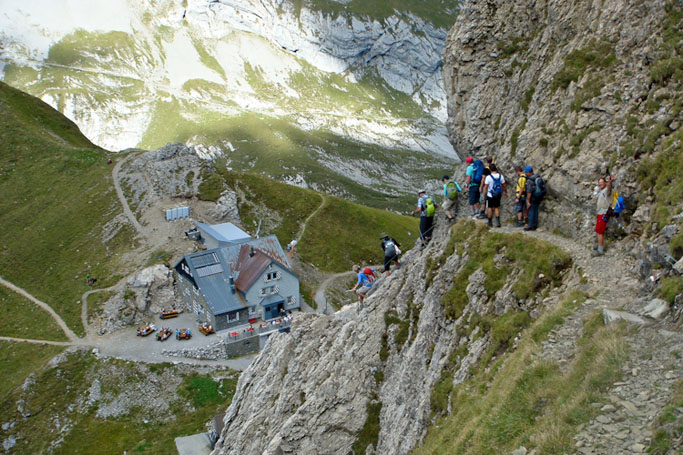The unique geography of the Appenzell region, coupled with its fascinating culture and history, makes Appenzell a fun destination for the adventurous hiker. Folded mountain peaks rise abruptly from pristine pastures while local farmers, dressed in traditional costume, move their cows between the valleys and hills.
The Hiking
In addition to cross-border views, the Alpstein mountain range also benefits from a highly developed trail system, due in large part to its proximity to St. Gallen, one of Switzerland’s smaller but important cities. The residents of St. Gallen favor the Alpstein for their weekend hiking retreats, and as such, they’ve engineered hiking trails in many imposing and unlikely places. The hiking is quite extensive for such a small mountain range, and if you like airy ridgewalks, cliffside trails, and caves, then this region is for you. (Less exposed options are also available).
Alpine Huts
An elaborate hut system also exists in the Alpstein, which allows hikers to travel deeper into the range than might otherwise seem reasonable. We call them huts, but the mountain guesthouses in Appenzell actually offer a higher level of service than standard Swiss mountain huts, many of them offering private rooms, hot showers, fluffy down beds and culinary delights. The mountain houses in Appenzell are, in fact, more reminiscent of well-appointed Austrian berghauses, which makes sense considering that Austria borders Appenzell.
Traditions and Culture
While the hiking in Appenzell is varied and exciting, it is the traditional way of life that enchants visitors in this tucked-away corner of the Swiss Alps. Appenzell boasts a highly pastoral culture, even by Swiss standards, which occasionally makes Appenzellers the butt of fireside jokes. Laughter aside, farming is the essence of the Appenzell way of life.
It is not uncommon to see Appenzell farmers in the high mountain pastures walking barefoot and wearing traditional leather shorts and suspenders adorned with hand-hammered brass medallions of cows and goats. Every fall, the people of Appenzell hold a grand celebration for the homecoming of the cows. They parade the cows through town with costumes, music and a level of flower-filled Swiss-ness that would make even the most jaded traveler want to jodel.
There is an old saying that you can “turn your watch back ten years when you cross into Appenzell.” Indeed. In our opinion, Appenzell represents the last bastion of old Switzerland and offers a unique opportunity to see the country the way that it existed centuries ago.
Notable Villages
Appenzell. This is the principal village of the region and serves as a colorful base for exploring the region. This quaint village, little known to American tourists, proudly boasts its traditionally painted houses and its quirky local government, which includes an annual election by shouts and a show of hands.
Cuisine
Appenzell prides itself on a highly evolved culinary tradition. The proximity to Austria and larger cities like St. Gallen inspires a range of cooking from exquisite continental cuisine in the towns, to superb and satisfying traditional dishes in the high mountains. Of course, Appenzellers would be furious if you didn’t mention their cheese, and for good reason. Creamy and bursting with flavors of lush pasture and high alpine meadow, Appenzeller cheese is what most experts and aficionados declare to be the best cheese in Switzerland. To prove it, Appenzeller cheese wins annual awards regularly.
Geography
The predominant mountain range in this part of Switzerland is called the Alpstein, which comprises a smaller sub-range called the Säntis-Churfirsten. The Säntis is the tallest mountain in the Alpstein massif, and, while not extremely high when compared with other Swiss peaks, at 8,208 feet the Säntis summit rewards hikers with views across the Swiss border and into Austria and Leichtenstein.
Towering out of the eastern region of the Appenzellerland up to a height of 2500 meters above sea level, the Alpstein massif is a range of folded mountains that amazes even non-geology experts when they find themselves in its midst. Around 15 million years ago, the flat area that is now the Appenzellerland was caught by the thrusting forces of the African continental plate as it pushed northwards, causing spectacular folds and breaks in the rock. The peaks of the region are limestone, which dissolves in rainwater more easily than other rocks. The result is an elaborately sculpted karst topography filled with sinkholes, caves and odd formations occurring throughout the range.









Comments are closed.